Objects in Breaking Bad: If Things Could Talk
“In a world of trouble I’d be/If things ever told on me./My whole life would be through/’Cause I’m guilty how about you?”
-Robert Miller, “If Walls Could Talk”
Breaking Bad – described as a “spaghetti Western” by creator, Vince Gilligan – is a modern epic tragedy of Shakespearean proportions in which a mild-mannered high school teacher’s moral descent warns of the dehumanizing perils of objectifying people for personal gain. Because of its premise – character transformation – Breaking Bad is a challenging series to comprehend beyond the literal level, its objects often operating as oracles, exposing buried subtexts and tragic character flaws unrealized by the characters themselves. At the same time that Breaking Bad‘s characters undergo chemical-like change, objects reveal the more static subtexts for all major characters – Walt, Skyler, Jesse, Marie, Hank, and Gus.
Literally, Breaking Bad is the story of Walter White, Sr. – 50-year old underemployed high school teacher; financially-strapped scientific genius; milquetoast husband to wife, Skyler – and his Satanically proud reaction to having terminal lung cancer. We witness the onset of Walt’s moral decay while he accompanies, on a bust, his DEA agent/brother-in-law, Hank Schrader, married to Skyler’s sister, Marie. As the bust occurred, Walt spied former student, Jess Pinkman, escaping the crystal meth “cook” site. Rather than turn in Jesse, Walt, seeking income, found and blackmailed Jesse into becoming the distribution end of his own proposed meth-cooking operation, which soon landed them neck-deep in violent criminals and ultra-high-demand meth. In spite of this, Walt rejected the free-chemo offer of former lover, Gretchen Schwartz, and her husband, Elliott, believing they had stolen from him, Gray Matter, a company that he, in fact, had abandoned. Through a series of plot twists, Walt and Jesse began cooking meth of unprecedented purity in a high tech, state-of-the-art laboratory fronted by fast-food entrepreneur, Gus Fring, whose worldwide meth operation angered a rival drug cartel. Eventually Walt, dying of cancer, killed the conservative but psychopathic Fring, only to inherit a meth empire he couldn’t run. In the end, Walt gained fleeting – gone before his death – wealth, respect, and a legacy at the cost of family and soul.
People, Places, and Things of Walter White, Sr., Empty Emperor
Throughout Breaking Bad, objects tell Walt’s true story while he weaves his deceptive tales. In fact, from the start, the White’s relationship is a lie based on Walt’s need to “be a man,” an opportunity Gretchen’s wealth – which, in Walt’s mind, would’ve made him a “kept man” – could not offer. Sadly, the urgency of terminal cancer emboldened Walt to become self-made… by “breaking bad.”
Exhibit 1A: Walt’s Name
“Walter” means “ruler of the army.” Aptly, one of Walt’s first acts as a (cost-cutting) drug emperor was to kill Gus’ imprisoned, hush-money-silenced crew via a paid convict-army. But as victims, they were far from alone: anyone – from criminals (Crazy-8, Tuco, and Gus Fring) to strangers (Jane, her father, and the plane crash victims) to his own family – blocking Walt’s plans became collateral damage. The meaning of Walt’s middle name, Hartwell, is ironic since his heart is anything but well and is, like his street name indicates, a dry, black river. Initially, Walt’s actions seem justified, but his dry, black heart becomes more evident with each heinous act.
Exhibit 1B: Walt’s Pants
Meth-cooking Walt removed his pants as an act of symbolic defiance against Skyler’s dominance. “If I can’t wear the pants,” his pantslessness said, “I will master you without them.” The morning after the Skyler-controlled “talking pillow intervention,” Walt agreed to chemotherapy, secretly rejected the Schwartz’ offer to pay for it, and – when learning that headstrong Skyler secretly informed them of his cancer – justified to himself his plan to cook meth for money. Walt believed that he had regained manhood (his pants) by refusing the Schwartz’ help, but the emasculating act of cooking meth was the heart of his plan.
While buying pants for his son, Walt’s dormant masculinity bravely awoke as he attacked the young man mocking Walter, Jr.’s disability. Gilligan’s siren seduction presents Walt initially as a dying, fed-up Everyman valiantly fighting for his son against a large bully; in fact, Walt is an emerging monster. On the other hand, Gilligan couched Walt’s first great act of cowardice – murdering Emilio Koyama just before the mad-scramble-Winnebago-crash left Walt sans pants – as a manly, pragmatic act of desperation. But the pants flew (i.e., Walt lost his manhood) after Walt cooked meth – his fate/God-defying attempt to capture his life and manhood – releasing from Pandora’s box Emilio’s murder and forfeiture of his own manhood. “You took another’s manhood today/Watch your own, in pants, fly away,” the siren sang, Walt crashing his ship into the New Mexico “shore.” Free of pants, dignity, and manhood, Walt weakly acceded to death-by-cop before learning the siren was from a fire truck, its laughterous sound deriding pantsless-Walt’s absent manhood.
The Crazy-8 Exhibits: 1C, The Coin Flip; 1D, the Bike Lock; 1E, The Broken Plate: 1F, His Name
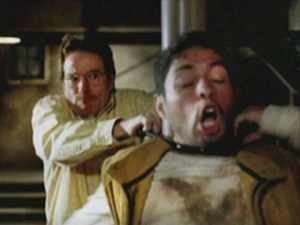
The coin flip set Walt on his darker, fateful, murderous course, determining that he would kill Crazy-8, and that Jesse would dispose of Emilio’s corpse. The coin symbolizes fate; the coin flip, life; and, as Jesse said, “The coin flip is sacred.” Though damning to Walt and merciful to Jesse, the coin toss alludes to God’s sovereign prerogative explained in Romans 9:21-23:
Does not the potter have the right to make out of the same lump of clay some pottery for special purposes and some for common use? What if God, although choosing to show his wrath and make his power known, bore with great patience the objects of his wrath—prepared for destruction? What if he did this to make the riches of his glory known to the objects of his mercy, whom he prepared in advance for glory…”
Walt’s loss is Jesse’s gain as Walt – like Pharaoh, whose heart God hardened – apparently cannot alter course. In this incident, Jesse, whose name means “God’s gift,” defeats Walt, ruler of the army. Evidently, who is over you is more important than who is under you.
The bike lock – which Walt used to kills Crazy-8 – is an obvious symbol in the scene, representing both Walt’s bondage to meth production and, ironically, Crazy-8’s freedom from this world’s troubles. Another symbol of bondage, handcuffs, appears in the series finale, “Felina,” Walt sacrificing the remains of his fetid soul to release from the Nazis the handcuffed Jesse. Walt rightly sees freedom in his cancer diagnosis, but unlike Odysseus — he and his crew saved by his mast-bondage — Walt’s freedom destroyed him.
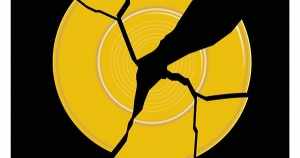
Serving a sandwich to Crazy-8, Walt breaks the plate and Crazy-8 hides a sharp piece with which to stab Walt. The broken plate symbolizes Walt’s soulless life, created to serve but reduced to a desperate, failed tool of destruction. Walt noticed the plate’s incompleteness – Crazy-8 holding the missing piece – but ignored his own brokenness. Combined with the bike lock, the broken plate also symbolizes Walt’s desperate (Skyler’s description of Walt’s fake can’t-we-all-just-get-along appeasement breakfasts) last days, paralleling Satan’s unshackling described in Revelation 20:7, 8: “When the thousand years are over, Satan will be released from his prison and will go out to deceive the nations in the four corners of the earth–Gog and Magog–and to gather them for battle. In number they are like the sand on the seashore.”
The first known grain of sand – unlike Emilio, whom Walt never got to know – appearing on Walt’s second day of his dark, twisted “creation” was Crazy-8. Lying dead-flat, the “8” in Crazy-8 indicates the infinite number of lives – as numerous as the grains of sand on the seashore – that Walt eventually would harm. Also, Crazy-8’s name is ironic since he was cerebral, practical – possessing a degree in business administration – and, like Jesse, disdained his unappreciative father.
Exhibit 1G: The One-Eyed Bear

Season two begins with a still, strange, mostly black-and-white chronological video montage: a dripping hose; an outdoor decorative lantern; a snail sliding on the top surface of a stuccoed cinder block wall; a glass of water on a patio table. Finally, the camera moves on to a scene of debris in a swimming pool: a floating plastic eyeball, and some final, full-color subaquatic shots of a one-eyed pink teddy bear floating face-down in the swimming pool, a distant police siren droning. Ironically, the montage’s focus is not the objects, but the seer of the objects, and the seer, having considered each item, is satisfied by the montage’s final full-color focus, the bear. At that point, like the crucified Christ becoming sin for mankind, the seer becomes the bear. The montage also promises that the snail-like conscience, like a droning siren, will eventually deliver God’s justice if man cannot. As the saying goes, “God’s gears turn slowly, but finely.”
According to Breaking Bad creator, Vince Gilligan, the bear symbolizes God’s omniscient eye. It also seems to represent God’s omniscience in finding – like the seer in the montage – and avenging anyone, such as the plane crash victims, harmed by a monster such as Walt. The seer finding the bear before the police symbolizes the superiority of God’s justice to human justice, recalling Matthew 10:29, 30: “Are not two sparrows sold for a penny? Yet not one of them will fall to the ground outside your Father’s care. And even the very hairs of your head are all numbered.” One wonders whether a humbler Walt – one who could accept employment at Gray Matter from the Schwartzes – would have survived the cancer, one knows it would have been better, if not well, with his soul. The question turns Walt’s original gambit – “I’m dying and have nothing to lose” – upside down: Walt is losing the most important thing of all, his soul.
Certainly no one could have predicted that a Walt-caused two-airplane collision would create the witness bag debris. After all, he’s only doing what’s “best for the family,” so what possibly could go wrong? But the bear witnesses the end of any semblance of Walt’s innocence, observing his complicity in the deaths of Jane, her father, and the plane load of innocent people. The discomfort caused by the symbolic bear, one of TV’s great red herrings, was ironic – causing viewers to assume that tragedy had struck the Whites – since the bear, a symbol of comfort, reminds that God forgets no victim.
The bear’s half-burned face foreshadows both Gus’ fate and the emergence of Walt’s explicit two-facedness. Before the plane tragedy, possible rationalizations for Walt’s murders may have existed, but after the disaster, Walt is without excuse. Through identification with Walt’s sufferings, the show seduces viewers into mourning the possible loss of Holly – “Is that her Teddy bear?” – while excusing the Walt-caused deaths of innocent travelers. The seduction complete, the fooled viewer either must run from identification with Walt – like Joseph from Potiphar’s wife – or, like Walt, cling to vengeance like a sword.
Exhibit 1H: The Matches Thrown into the Pool
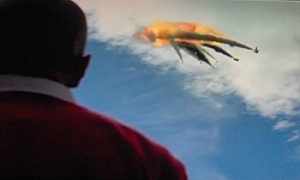
After Walt learned that he had caused a plane collision, he tossed lit matches into the pool. The matches seem to represent the lives lost in the crash, the scene showing Walt in a brief existential crisis, soon likely patched over by his all-purpose mantra, “I did it for the family.” If so, the pool’s blue water would then seem to represent the infinite sky from which the planes fell; the Sky(ler) blue, infinitely-second guessing wife; and Walt’s blue meth, the finite purity with which he’s infinitely obsessed. But mostly, the blue pool represents Walt’s bottomless greed and infinitely empty soul. Walt’s unwillingness to go gently into the good night of mortality sends others there instead. Also the site where Walt’s first burned his money then extinguished it in the water, the pool seems to be where Walt drowns his conscience.
Exhibit 1I: One-Eyed Jacks
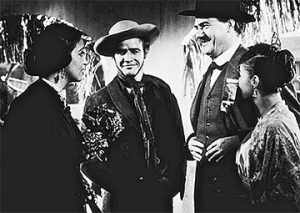
Series creator, Vince Gilligan, has stated that Breaking Bad is a spaghetti western. It also contains – like the true spaghetti western, The Good, the Bad, and the Ugly – a character named Tuco. But thematically, the western that Breaking Bad‘s one-eyed bear recalls is Marlon Brando’s One-Eyed Jacks. In the film, the duplicitous Dad Longworth – played by Karl Malden – took the pair’s bank robbery money to buy a horse for Rio – played by Brando – but failed to return, abandoning Rio to capture and prison. Years later, Rio found Longworth a superficially respectable sheriff. Upon seeing Rio, Longworth made excuses, ala Walter White, for not returning to rescue Rio who, unfooled by Longworth’s excuses or new life, stated, “You may be a one-eyed jack around here, but I’ve seen the other side of your face.” Like Walt, Longworth feared the exposure of the other side of his face.
To avenge Longworth’s abandonment, Rio bedded Longworth’s daughter, Louisa, but afterward committed to her while confessing his motive: trying to have a secret, nefarious face like her father’s. Meanwhile, the elitist Longworth showed his wife his icy, hidden face, reminding her that he rescued her from a “bean field.” Like Jesse’s love for Jane and Andrea, Rio’s love for Louisa is pure; like Walt’s “love” for his family, Longworth’s is warped. In the end, Rio and Jesse live on, while Longworth and Walt suffer similar ignominious ends.
Exhibit 1J: Walter’s Home Address
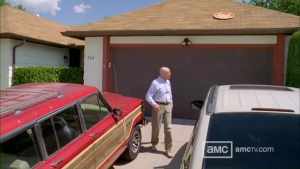
Walter’s street, Negra Arroyo, means “black, usually dry riverbed” in English. Unlike One-Eyed Jacks‘ good Rio, Walt’s heart is a dry, black river, his dishonesty and superficial respectability like that of the despicable Dad Longworth. Like Rio, the goodhearted Jesse survived; like Longworth, the evil Walt was killed. In the end, after Walt returned from New Hampshire, the swimming pool – where he threw his money and the lit matches, and where Skyler, like Hamlet’s Ophelia, tried to drown herself – was as dry as his soul.
Similarly, there is a disagreement between the masculine noun, arroyo, and the feminine adjective, “negra,” indicative of the White’s constant contention. There is also disagreement in the Whites having lived on, translated, Black Dry Creek Street. The black-white contrast could also be a comment on the uncompromising nature of both Walt and Skyler, as well as a remark on the sharp line between good and evil, a line which Walt fuzzied with his gray matter.
Revealing, too, is the fact that the address’ syntax is incorrect in Spanish, which, unlike English, places nouns before adjectives. Negra Arroyo incorrectly places the adjective, Negra, which is feminine, before the noun, Arroyo, which is masculine. The word reversal seems to indicate the Whites’ marital power struggle that Jesse pointed out, saying to Walt, “Way to wear the pants in the family.” No doubt Jesse’s comment reflects something of his own bias, but likewise notices Skyler’s inability to control her impulses.
Exhibit 1K: The “Live Free or Die” Volvo

Walt returned to Alberquerque driving a low-budget version of Gus’ button-down Volvo. While Gus used his nerdy Volvo to hide in plain sight, Walt’s imitation with the ironic New Hampshire “Live Free or Die” license plate is an attention-getter. Predictably, Walt is noticed immediately by a neighbor. Unlike Gus, whose evils became known post-mortem, Walt’s infamous face is ubiquitous.
Exhibit 1L: Elements 50, 51, and 52 of the Periodic Table
Walt’s 50th birthday cup is a symbol of himself. When Skyler ashed her cigarette in Walt’s cup – after she found out he’d been cooking meth and, more importantly after she learned of his cancer – her passive-aggressive message was that she wanted him dead. Even the numbers on the Periodic Table of the Elements seem to have symbolic meaning. For example, entering age 50, Walt the wimp was as common and cheap as element 50, tin.
At age 51, Walt became more violent, resembling element 51, antimony, which, when alloyed with tin and lead, improves bullets. Antimony also has been used since ancient times as a remedy for eye ailments and as an eye cosmetic. Walt, at 51, also became increasingly unable to see himself, while and lost more of his responsible citizen “makeup.” He also became more familiar with bullets as time passed.
By age 52, Walt had become as volatile as an explosive form of element 52, tellurium, that produces white (as in… Walter White?) fumes when scratched by a sharp object, or detonates when crushed by a mortar in a pestle. Sounds a lot like the 52-year old, Live-Free-or-Die, machine-gun-in-the-trunk Walt.
Exhibit 1M: The Heisenberg Pork Pie Hat
When Walt wanted to assert his assumed godlike status, he donned his Heisenberg pork pie hat. The Charles Mingus-penned Goodbye Pork Pie Hat – a eulogy to fellow jazz great, Lester Young, who died at 49 – reveals the hat as a symbol of both mortality and true greatness in a legitimate field of endeavor. Sadly for Walt, the hat reminds that he, having wasted his talents on revenge, was no Lester Young. Likewise, when Jesse called Walt an artist, Walt corrected him, saying, “It’s science.” Walt’s milieu, the world of heartless planning and precision for revenge, is in stark contrast to the beautiful soul of jazz improvisation. Walt – whose pursuit of meth perfection caused him to obsess on a single, unwelcome fly in his lab – fits in in a jazz club like a mattress balances on a barrel of methylamine.
Upon entering the meth world, Walt said he was awake, created an alter ego – Heisenberg, after the Nazi scientist – and used the persona to attempt to reach perfection. Walt also nearly destroyed Jesse in the process. At his nadir, Walt undid a small part of his hubris- and folly-driven madness in a vain attempt to redeem the surviving sliver of his soul by killing Nazis, sans Heisenberg hat. The event – a desperate, full-circle flight validating Walt’s life as vain – freed Jesse, and the missing hat symbolizes the futility of Walt’s life. The missing hat also recalls Job 1:21: “Naked I came from my mother’s womb, and naked I will depart. The Lord gave and the Lord has taken away…” Walt saved Jesse’s life as hatless Walt, not as hatted Heisenberg. Like Job, Walt may have been asking of his vain life, “Why died I not from the womb? why did I not give up the ghost when I came out of the belly?”
Exhibit 1N: The Generator Crank
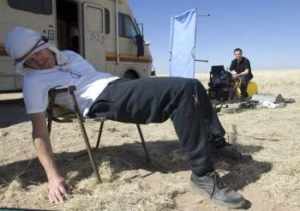
In “4 Days Out” (S2 E9), Jesse asked Walt how much longer they had to crank the generator crank, and Walt answered, “I don’t know.” Walt’s answer parallels both the subtextual questions of how much longer he will live, and how much longer he will stay in the meth business. When Jesse prayed, “Please, God'” – when the Winnebago wouldn’t start – and asked himself, “Why couldn’t I have gone to Santa Fe?,” Jesse questioned his apparent fate. In that sense, the crank is a symbol of fate being in one’s own hands. “How long,” the crank asks, “will you continue to fight your fate? You have cancer. If there’s a God, you are about to meet Him, and no amount of turning can change that.”
Walt seemed to accept his fate – of dying in the desert or being caught or both – when Jesse discovered him, coughed-up blood in his hand. Walt confessed, “I have this coming. I deserve this,” but Jesse’s innocent counter included the phrase that Walt adopted as his guilty alibi: “Hey snap out of it. Everything you did you did for your family, right?” Walt’s answer was, “All I ever managed to do was worry and disappoint them and lie. Oh God, all the lies.” Although it seems the still-confessing Walt had not heard Jesse, we learn he had, and it is why Walt kept Jesse around: Jesse’s conscience, a word meaning, “against knowledge,” provided answers manipulated by Walter Hartwell White, Sr., conscienceless practitioner of science, a word meaning “knowledge.” Both men turned the crank of fate, and mentioned God: Jesse begging for help, Walt making a short-lived confession about his lies, and each man’s fate was drastically different. Also, the word, “crank,” a synonym for meth, expresses the fact that each man allowed his fate to be “turged” by the likes of drug dealer, Tuco Salamanca.
People, Places, and Things of Skyler White, Ubiquitous Sky
Exhibit 2A: Skyler’s Blue Name
When Saul Goodman first met Skyler, he gushed that her name and attractiveness reminded him of a blue sky. The reference seems to mean that the vast sky of the treeless desert best reflects Skyler’s ubiquitously controlling personality. Skyler liked to make the family’s decisions and had for years until Walt confused manning-up with breaking bad. Impulsively, she revealed Walt’s cancer without his permission; then decided – again, without Walt’s permission – that the alibi for their newfound wealth was gambling; and – perhaps afraid that she would miss driving Walt’s meth-train – decided that the money should be laundered her way, via the car wash, apparently because her fear of losing control was stronger than her fear of incarceration. Gilligan’s intentionally ambiguous style of characterization leaves viewers in limbo: is Skyler as bad as Walt, or is she more a victim of his choices?
Exhibit 2B: Skyler’s Blue Swim
Skyler realized Walt was a monster early in season five. In Madrigal (S2E5), Walt addressed the guilt Skyler felt regarding Ted’s injury, saying, “You know, it gets easier. I promise you that it does. What you’re feeling right now… about Ted… Everything. It’ll pass.” Unlike Walt, who excused himself for all of his misdeeds, Skyler could not rationalize her part in Ted’s downfall (pun intended). The scenes in which Walt continued his rationalizations while caressing the spiritless Skyler are icky, Walt’s scaliness almost palpable: “When we do what we do for good reasons then we’ve got nothing to worry about. And there’s no better reason than family.” Walt held a facing-away, silent Skyler in bed in this episode and in S5E4, “Fifty-one,” her face apparently expressing blank resignation and trepidation. It seems she had given up, Walt reveling in her disintegration. Skyler, the former spirited control freak, apparently had been mastered by Walt the control god. Wallowing in his victory over over Skyler, Walt, patronizingly gentle, requested chocolate cake with chocolate icing for his upcoming birthday party. His real celebration was not for his birthday, marking a year of mastering cancer, but a private celebration of mastering his most recent victim, Skyler. In evident will-less compliance, Skyler, reduced to a tool of Walt’s will, robotically served the cake at Walt’s party. But, as is so often Vince Gilligan’s aim, the ambiguity of Skyler’s impassivity may not have been an actual sign that she had given up at that point.
In S5E4, “Fifty-one” Skyler walked into her pool in an apparent attempt to kill herself. It is difficult to tell whether the breakdown was real. On the one hand, Skyler – symbolically the enveloping, dominating blue force in her marriage – and narcissistically immersed herself in the sky-reflecting water of her own pool. If she truly had felt a loss of identity, her actions might seem, metaphorically, a way to reclaim self. Likewise, one suffering a suicidal loss of identity paradoxically brought on by losing control over another person would be a pretty sick person.
On the other hand, there are reasons to doubt the sincerity of Skyler’s breakdown, which appears self-serving rather than self-annihilating. First, her “swim” is done in as public a setting as would benefit her cause without being too public. If her goal was to communicate Walt’s incorrigibility to only the people closest to them, she succeeded brilliantly. Second, her “breakdown” too neatly mirrors Walt’s faked, naked-in-the-grocery-store “breakdown”; she may have been mocking him while getting revenge. Third, she receives pity for an apparent breakdown without having to divulge self-incriminating specifics. Fourth, like she did at a get-together not long after his 50th birthday, Skyler here upstaged Walt on his 51st birthday with her own apparent fugue state – his in the desert, hers in the blue water. Also, Skyler’s “breakdown” surpasses the results of Walt’s “breakdown” with less “heavy lifting,” as she effectively communicated a general message to a specific audience that something horrible had happened in her marriage, without having to humiliate herself through public nudity or checking into a hospital as did Walt. Skyler merely took a couple of aspirins and went to bed.
It would be easy to cynically conclude that, whether shakedown or breakdown, water seeks its own level, and Walt and Skyler deserve each other. Likewise, to see Skyler as “the dry,” and Walt as “the black” of 308 Negra Arroyo Lane is convenient but inaccurate. On the one hand, Skyler’s flaws are in her uncompromising nature – she’s difficult, but not evil – while on the other hand, Walt personifies evil.
Exhibit 2C: Her Son’s Cerebral Palsy

It seems Skyler may have had a subconscious recognition and fear of the dormant malevolence of Walt’s intellect – call it female intuition if you’d like, or perhaps she’s just impulsive and controlling? If the former, then she’s a failed but brilliant angel whose womb may have – to stop another monster in the family – preemptively struck Walter, Jr.’s brain, resulting in his cerebral palsy; if the latter, she may have attacked the boy’s unborn brain just as a means to control WWII’s intelligence, monster or no.
We see Skyler’s serial undermining of Walt, impulsively revealing the secret of his cancer to the Schraders and the Schwartzes, as well as blabbing to the Schraders that Walt’s windfall came from gambling. Stretched to the limit intellectually, Skyler may have feared raising another Walt. Much smarter than Ted Beneke, whom she saves from prison, but not as smart as Walt (who was?), Skyler often spoke without forethought, like the youngest child trying to keep up in a conversation, but from the beginning seemed to recognize Walt’s potential for evil. It seems she may have always sensed Walt’s darkness and stifled it through control. Therefore, it seems possible – it is fiction, after all – that the stress of Walt and Skyler’s toxic relationship may have poisoned the unborn Walter, Jr. Like mixing incompatible chemicals, a proud man plus a controlling woman equals a toxic environment.
People, Places, and Things of Jesse Pinkman, Catcher in the Rye
According to urbandictionary.com, a “Jesse” is a stoner popular with women, and Jesse Pinkman had two girlfriends in the series, first, Jane Margolis, and later, Andrea Cantillo. The more traditional and perhaps more significant meaning to Jesse’s name, in Hebrew, is “gift of God.”According to Walt, however, Jesse was a stupid drug addict, yet Walt mysteriously kept Jesse around long after it seemed necessary. Walt even returned in the series finale to free Jesse. We also know that Jesse’s relationship with his parents was broken, presumably as a result of his drug use. Objects associated with Jesse reveal much about his character and his upbringing.
Exhibit 3A and 3B: The Arachnids and the Boxes
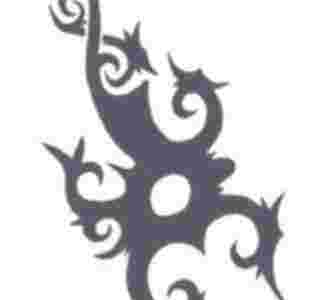
Jesse’s return to his childhood home revealed an underlying issue with his parents, explaining how he became the person he became. While looking through his childhood toy box, Jesse found a scorpion, a headless superhero, and a drawing of Jesse’s former high school chemistry teacher and then-current meth partner, “Mr.” White. At 33:29 into “Cancer Man” (S1, E4), the tattoo on Jesse’s right hand, called a Borneo Scorpion, is exposed as he picks up a toy scorpion. The scorpions symbolize the sting of his parents stealing his childhood; the headless superhero represents the intellectual disappointment that Jesse was to his parents; and the drawing of Mr. White showed Jesse’s gift as a sensitive artist in a sterile family appreciating neither sensitivity nor art. Just before Todd Alquist killed him, Drew Sharp had caught a tarantula, and in the horrible moment of the boy’s death, the tarantula – another symbol of a stolen childhood – became the scorpion and Drew Sharp became Jesse. The hatred that Jesse struggled to feel for his parents was the hatred he clearly felt for Todd Alquist. Unlike the confusion of a child suffering bad parenting, Todd’s intentions were never mixed, just as Jesse killed Todd with pure hatred.
In Jesse’s rehab support group, when asked of his ultimate avocation, Jesse first postured – “make fat stacks” – then said that he’d be a carpenter, recalling Christ, and told of the box he made in Mr. Pike’s class. At first, Jesse said, just wanting a D, he turned in a carelessly-made project. Mr. Pike looked at the box, said, “Is that the best you can do?” Mr. Pike’s query subtly communicated a confidence in Jesse, something lost on Jesse’s parents. When he shared the story at his support group, Jesse bitterly added that he didn’t give the box – a symbol of his potential – to his mother.
People, Places, and Things of Marie Schrader, Barren Princess
Exhibit 4A: The Color Purple
The color of royalty, purple – seen throughout her newly-built, comfortable home – represents Marie Shrader. She is the younger sister, the baby of the family, probably daddy’s little princess, the one who Skyler resentfully refers to as that, “kleptomaniac bitch little sister who always manages to be the center of attention.” In her make-believe, royal purple world, Marie is princess and Hank her brave prince, but in reality, the castle was damaged long before the dragon, Heisenberg, breathed fire on Hank. It’s not just that everything in her house was purple, it’s also that she wears purple clothes most of the time. And when Marie wasn’t in purple, she wore the black of a mourning mother. For Marie, purple is the color of her make-believe world, the color of her denial, a state in which she and Hank live as fictional royalty.
Exhibit 4B: Shoplifting, Theft
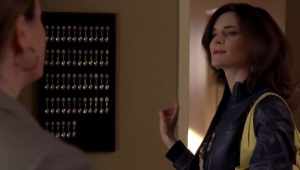
For no apparent reason, Marie stole four items in the series. First, she shoplifted a tiara for Holly’s baby shower. Then Marie stole from realtors’ open houses a baby spoon, a figurine of a boy riding a pig, and, finally, a portrait of an elderly couple selling their home. The order of the stolen items is key: A newborn’s tiara, an infant’s spoon, a figurine of a child, and a portrait of an elderly, empty-nest couple. After she was caught, Hank explained to a perturbed Skyler that Marie needed to be supported, but never divulged why. Stealing from the home owners in “Open House” (S4, E3), Marie wore black, mourning the loss of her chance at motherhood. Sadly, she also created fictional families with children for the stories she told the realtors. But why did a woman living comfortably steal items related to children? Because Marie desperately wants to be a mother, but cannot have children.
The implication seems to be that one or both Schraders was secretly sterile. Knowing Hank, we know also that his machismo could never take the publication of this news were it him, and Marie, her hidden anguish seeking comfort, steals items relating to children and family. Several times, Marie spoke disparagingly of the barren desert and glowingly of a move to swampy Washington, D.C. She also referred to Hank’s move to El Paso as a move to the country’s anus. Clearly, the desert’s barrenness – reflecting her own childlessness – was not Marie’s thing.
The Manly Exhibits: The People, Places, and Things of Hank Schrader, Amateur Geologist
Objects in Hank Schrader’s life belie his false bravado as well as defend it. Initially a hollow man, Hank died with dignity, telling Walt to stop begging to save him since Jack “made up his ten minutes ago.” Hank was Marie’s hero, her assumption of his impermeability angering him during his identity crisis: While he stared down his assumptions of masculinity, Marie unknowingly continued to prop them up. In the end, his fatal flaw – wanting so badly to slay the monster, Walt, – consumed him to the point that he allowed himself to be destroyed.
Exhibit 5A: His “Minerals”
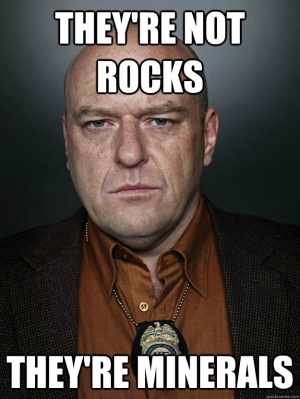
After Tuco’s twin cousins nearly killed Hank, he was scared, and Hank didn’t believe a man should be scared. Or sterile. Similarly, Hank feared that his boss, office mates, and – most deeply and importantly – Marie would know. Rather than risk Marie’s rejection, Hank rejected Marie, increased his false machismo, and bonded instead with his physical therapist. Hank, tied tightly to his chauvinist views of manhood, at one point rejected both his fear and Marie – in favor of his fearless, manly fantasy – as she delivered a fantasy football magazine, and almost caught him escaping into the fantasy world of porn. Hank, not yet ready to deal with his vulnerability and mortality, retreats instead into a world he knows well, the world of make believe.
While rehabbing at home, Hank, surrounded by Marie’s purple, picked up a hobby – buying minerals via the internet – that became an obsession. Whenever Marie referred to his avocation, she called the minerals “rocks,” annoying Hank, who impatiently corrected her every time. Literally, they are minerals, but in the meaning of the deeper text, they are Hank’s “rocks,” infertile for reproduction and, in his mind, bravery. As a proxy for his own self-doubted “rocks” (read, “manhood”), Hank bought big, heavy, impressive minerals (read, “rocks”). If Hank could have communicated his visceral frustration with Marie flippantly speaking of his rocks, he would have something like, “I always thought that ‘whistling through the graveyard’ was what made a man a man, but I can’t whistle since putting a man in the graveyard. I’m not sure what a man is anymore, but I’m pretty sure I’m not one, and you speak flippantly of my ‘rocks.'” While Walt excused killing hundreds of innocents, Hank wrestled with the death of a rat-man.
Hank’s Macho Exhibits: 5A, B, & C: The Gun, The “Grill”, The Beer
Hank’s gun, used to kill Tuco Salamanca and his two silent cousins, is a symbol his power as a man. Tuco’s surname, Salamanca, associated with Spain’s University of Salamanca, has been associated with or magic since the Middle Ages when it was first said that the devil taught magic there. In Crazy Hand Full of Nothing (S1 E6), Walt’s explosive sleight-of-hand in Tuco’s office set up their business agreement and, ultimately, Tuco’s fatal showdown with Hank. Hank learned that using a gun doesn’t make one a man, but because of killing another man, Hank faced what it really meant for him to be a man. Unlike Walt, who refused to face truth after avoiding it until the end, Hank faced down his fears, becoming a man.
Hank’s words in the talking pillow scene – “Maybe Walt wants to die like a man” – echoed in Walt’s death scene and his own, for both men died doing the right thing, though for Hank this was long part of his character. In fact, when Hank died, it was Walt who begged for Hank’s life while Hank said to Walt, “He made up his mind ten minutes ago,” and to Jack, his killer, “Do what you’re going to do.” In the end, his posturing done, Hank died as a man, showing Walt how to die. Regarding manliness, Hank was nearly as great a foil for Walt as was Jesse. Hank’s fumblings in his masculine identity remained mostly private and his sufferings remaining mostly inward, while Walt’s private crisis spread, serpentine, like the toxic meth he cooked. Despite his posturing, Hank became a full man who lived with infinitely more grace than Walt.
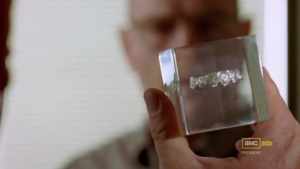
Tuco’s “grill” (his silver-covered teeth ) initially a gag gift from coworkers, became a symbol of the gap between Hank’s public persona and his private PTSD-fueled masculinity crisis. Hank laughed about the gift and Tuco’s death, while privately mourning the loss of his innocence and his former simplistic view of manhood. Hank kept Tuco’s grill on his desk, but it became not a shallow measure of masculinity, but a sad reminder that he had played God by ending another man’s life. Finally, Hank tossed the grill – a grim, sobering reminder that he’d done the most serious thing imaginable, taking another man’s life – shedding his belief that being a man included making unfeeling and shallow flippant wisecracks about gravely serious subjects.
Hank bottled his own beer, that symbol of American manliness. Instead of manliness, though, his beer exposed his vulnerability – an unmanly quality to Hank – and symbolized his sexual impotence and self-perceived weakness. In “Breakage” (S2 E5), Hank’s beer, improperly bottled, exploded while he slept, causing the post-Tuco-killing Hank to show his first signs of PTSD, and created in Hank both anxiety attacks and the beginning of his recurring masculinity-crisis.
5C: His Cuban Cigar
During a Hank-Walt conversation over a drink and Hank’s illegal Cuban cigars, Walt’s plays devil’s advocate, creating dramatic irony: we know Walt regards laws and morality as arbitrary, but Hank believes it to be the musings of an intellectual. Hank nibbled at legality – his devil-may-care attitude about banned cigars was his typical male posturing – while Walt suggested devouring all laws in one bite. The scene exposed both Hank as a boy scout boasting of the smallest of infractions and Walt as an amoral monster darkly whispering his deadly intentions.
Exhibit 5E: The Transformation of His Garage from “Man Cave” Garage to Crime Lab
It’s sort a sad comment on Hank’s masculinity that the area of his house that Marie calls his “man cave” was the garage. In it, Hank bottled his manly beer and probably retired when in need of a break from Princess Marie’s realm of ubiquitous royal purple. It is ironic that in this garage-corner of the castle, Hank, Marie’s brave knight, realized that the dragon-monster was Walt. In another sense it is fitting that Hank finds his true masculinity in the manliness of his garage.
6People, Places, and Things of Gus Fring (Fringe in the Middle), Hiding in Plain Sight
Like a most likely unintended namesake, Sweden’s King Gustaf III, Gus Fring was an understated but bold leader. In public, Fring acted humble and quietly generous, but in reality he was proud, selfish, and evil, putting his own wants before his fellow man’s needs, creating in them, instead, a dependency on his product, meth, and not a desire for his chicken.
Exhibit 6A: The Staid Volvo
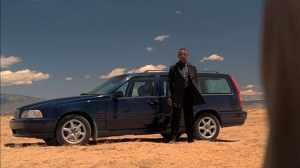
Gus Fring’s nerdy Volvo allowed him to hide in plain sight. After all, would a drug lord really drive such a dowdy car? Robin Williams’ joke, “Compassionate conservative? What’s that, a Volvo with a gun rack?” shows the underlying, undeserved reputation of the Volvo as a suburban sign of respectability, almost altruism. Gus, likely laughing to himself, used “respectable society’s” presumption against itself as part of an effective mask of nerdish conformity until Walt and Don Hector “Tio” Salamanca removed half of Fring’s face and all of his mask. Gus’ Volvo also symbolized the depth of sacrifice he had made to gain and maintain power, as well as the depth of his hatred for the cartel who killed his former partner, Max.
Exhibit 6B: The Box Cutter
It appears that Gus’ 20-year vendetta against the cartel was not as much about business as love. His Los Pollos Hermanos (“chicken brothers”) partner, Max, was also his lover. When Hector shot Max, Gus vowed revenge against the cartel. It just took him twenty years. The box cutter Gus used to slit the throat of his assistant, Victor – who also may have been a possible lover – sent two messages to Walt. First, if indeed Gus is a “chicken hawk” – slang for a gay man pursuing younger men – the message is that his love of the business that he started with Max knows no limits, and that not Victor or anyone else could ever take Max’s place. The box cutter symbolizes that the apparently passionless Gus is quite the opposite, willing to dispassionately drive a Volvo, wear a mustard yellow shirt, and live a lie because of passion. Gus’ murder of Victor also communicates that Walt will do as he’s told. It also tells Walt, “You are not my business partner; Victor was not my life partner. My only business and life partner was Max, and he is gone.” In no uncertain terms, Victor’s murder informed Walt that Gus was his superior; later, however, Walt’s wheelchair bomb, like a school teacher, corrected Gus.
Though certainly not an exhaustive list of symbolic objects in Breaking Bad, the objects included here seem to exemplify some of the important strands of some of the major characters in TV history’s most critically-acclaimed series. From Walt’s name to Gus’ boxy car and box cutter, objects truly do tell the often dramatically ironic stories of complex characters in a modern tragedy, the well far too deep for one 6900-word article to fathom. One example of an apparent allusion, unexamined here, is that of Tuco (“the rat”), a character from the Clint Eastwood spaghetti western, The Good, the Bad, and the Ugly, representing one of the many graves left unexhumed by this article. Another opportunity for Breaking Bad fans is the final episode’s title, Felina, also being the name of the dancing, beloved girl in the Marty Robbins-sung El Paso. More than any other show, Breaking Bad seems to be the series discussed in a generation or more when screenwriters discuss not only the treasure of unearthing complex, well-written characters with subtexts, but the subject of much analysis by readers discovering the wealth of new finds.
What do you think? Leave a comment.
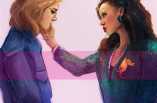
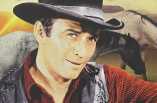
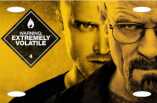

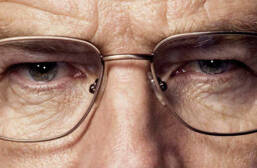

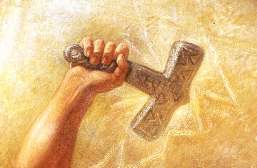
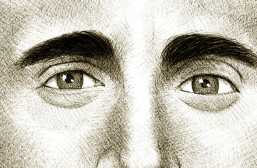

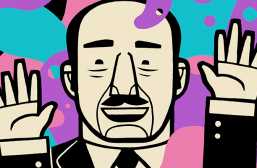

My favorite object was the fly. I believe ‘Fly’ was an elegant and beautiful episode of the series.
I wish I’d explored the fly. I think the fly is the difference between perfect and imperfect, eternal and temporal, Walt’s 99%+ meth and pure meth, man and God. Walt fails – and falls attempting – to remove the fly, become perfect, become eternal, purify his meth, and kill God and replace Him.
It’s disappointing to see “Walt gear” – mainly t-shirts and bumper stickers – saying “I am the one who knocks,” “Say my name,” etc. when the point in his character’s downfall is that pride, revenge, etc. killed his soul, that he people are not omnipotent. Somehow series creator/writer Vince Gilligan’s statement, “… if there is no such thing as cosmic justice, what is the point of being good?” has been misunderstood. In the beginning, Walt was the poor, henpecked husband with cancer; then he becomes evil.
Use of the name, Heisenberg, also shows Walt’s simultaneous evil and impotence: both men used their brilliance for evil; and both men failed to achieve their ultimate goals – a German atomic bomb for the former; perfect meth, a legacy, and his wife’s respect, for the latter.
Fun episode to see Bryan Cranston play Tom and Jerry with an insect.
That’s funny, and I actually did lol. Talk about obsessed. Reminds me of digging into the toilet for heroin in Trainspotting.
I’m glad they mentioned Walter’s pants. I have always felt throughout this series that his wife was very controlling and he did things only because she wanted them done. I know that he had to cook the meth because he needed money for chemo but, in a way I feel like he cooked the meth because he didn’t want chemo and this was a way of rebelling against his wife.
What I’ve learned from Breaking Bad? Whatever happens, don’t use the box cutters. The box cutter was a devastating weapon.
God this is too much. What am I supposed to do for the next 7 days
Do some meth.
Has anyone noticed the constant placing of scales between Walt. In 509 they placed the scales in between the blood money. Then they placed Walt and Jesse on opposite end with blood money between them.
Daniel 5:27 “You have been weighed on the scales and found wanting.”
It’s the best programme on television and in my top 5 of all time. the show is brutal and so left field. i just love the atmosphere of it.
Brill, the scales remind me of Daniel 5:27: “You have been weighed in the scales and found deficient.” Walt is deficient, Jesse is not.
It’s wonderfully cinematic, and yet manages to explore a depth of character which has hitherto been unavailable to cinema, and absent through fifty years of television drama.
Good observation you have.
Tony Montana from the remake of Scarface and Walter White are polar opposites who experience the exact same results upon their introduction into the dope business.
Song, your point reminds me of Tolstoy’s – “Happy families are all alike; every unhappy family is unhappy in its own way” – with which, probably in my misunderstanding, I fundamentally disagree. Reducing others to objects (as does hatred, greed, etc.) results – coincidentally, poetically, and justly – in objectification of self, the opposite of individuality. Therefore, it would seem that unhappiness robs a family’s individuality. Perhaps Tolstoy, being a Christian, was emphasizing the narrow gate of Matthew 7:13. In a battle of a priori’s, however, I’m pretty sure Tolstoy would be rock, and I’d be scissors.
They do the bowl of oranges thing. in season 4, ted goes into a bowl of oranges as he dies, then later in the nursing home for the last time, there is a bowl of oranges in the background a minute before the big explosion. keep an eye out for more. i can’t remember if it’s gus or tio, but the scene is shot so the oranges are in the background and then the persons face comes over the oranges before cutting away.
I’ll have to go back and look for that. I remember Ted and the oranges, but missed the second reference.
I think him keeping the eyeball from the teddy bear is about him reminding himself, and the audience of the ramifications of his actions.
Yes, God’s omnipresent omniscience.
The teddy bear with a half face is one of the more famous foreshadowing of Gus getting blown up and ending with half a face.
What a great TV series and Aaron was brilliant as Jesse and throughout his journey from cowardly down and out loser, drug dealer and addict to sympathetic hero.
There’s also a new show he stars in and produces called The Path. It’s about a weird and dangerous pseudo-religious cult that has nothing to do with Scientology. Even though you may think it’s about Scientology, it’s not about Scientology. Just to be clear (no pun intended) The Path isn’t about Scientology.
You mean just so you’re “clear” on that.
I like ‘Better call Saul’ but I must admit I’m really only watching it in the hope that Jesse makes an appearance. Aaron Paul was brilliant in the role, just mesmerising. I remember being almost unable to watch the last episode of ‘Breaking Bad’, so fearful was I that he would meet a bad end. It’s rare for me to be so invested in a fictional character, but he really was that good.
Since Jesse represents goodness – in a “born pure,” Rousseauesque sense – the fact that you identified so closely with him speaks highly of yourself. They should make a test based on BB to learn how vengeful, merciful, etc. people are.
Excellent show! Me and my brother usually spend our time watching breaking bad and when we aren’t, we spend the rest of our time quoting it and discussing our favourite scenes and characters.
I binge-watched Breaking Bad a few months ago after refusing to watch it for years (the cancer aspect of it put me off, as my dad is fighting oesophageal cancer). I’m glad I did. It’s a show which respects the audience, doesn’t spoon-feed you morals or character motivation and which I can’t seem to stop thinking about. I haven’t had a show affect me that much since The Sopranos ended.
Sorry to hear about your dad.
I agree, the Sopranos is excellent. I also agree that BB doesn’t patronize.
I really, really like this. I never noticed the connections and objects to this degree.
Thanks. I never despised Marie, like some do, so when I discovered her theft was based on infertility, I just bowed toward LA in awe of Vince Gilligan’s writing.
I like your analysis a lot, thanks for writing it.
My pleasure. Thanks for reading.
Everything is foreshadowing in Breaking Bad.
Even the last scene.
I would like to see a Badger and Skinny Pete spinoff.
Especially Badger. This is still one of my favourite things ever:
https://www.youtube.com/watch?v=F-V75LKwLNk
I have no idea what the lock pick symbolizes… nor do I want to know.
No other TV show of this decade had had such brilliant pacing.
Yes, and it starts from the very opening inexplicable scene.
Either Breaking Bad is incredibly-heavy handed, or its viewers are some of the most observant fans I know of.
I wrote you a reply, but attached it to the wrong person. I guess I’m not very observant.
Ola, if you haven’t seen the series, I can only tell you that it begs closer observation. When I hear heavy-handed, I think of a particularly horrible scene from Oliver Stone’s “Natural Born Killers.” In it, Stone hints that watching too much tv is the cause the duo’s violence. Then he drops another hint, and another, ad nauseum; finally the words “TOO MUCH TV” appear on the wall. I’m sure Stone would claim use of imitative form (which in itself is awful), but the result is painfully heavy-handed. He did the same in “Nixon” by flashing an almost subliminal-few frames of some microorganism or cell under a microscope amidst Tricky Dick sweating a decision. His heavy-handed point? Nixon couldn’t help his megalomania; it was cellular. In “Breaking Bad,” ideas are subtly portrayed through the plate, the coin toss, etc., and are usually not re-referenced. The pace of the show is also too fast for heavy-handedness. Interpreting “Breaking Bad” on the fly is like trying to interpret a great Dylan song on the fly: good luck. After seeing it, I tried a few other shows to no avail.
In season 2, the episode where Walt and Jesse get stranded in the desert, there is a shot of the sky with a plane flying over. If I remember correctly, the shot transitions, making the plane fly into the other plane’s paths, intersecting. Could be a little foreshadowing of the planes colliding.
Ola, if you haven’t seen the series, I can only tell you that it begs closer observation. When I hear heavy-handed, I think of a particularly horrible scene from Oliver Stone’s “Natural Born Killers.” In it, Stone hints that watching too much tv is the cause the duo’s violence. Then he drops another hint, and another, ad nauseum; finally the words “TOO MUCH TV” appear on the wall. I’m sure Stone would claim use of imitative form (which in itself is awful), but the result is painfully heavy-handed. He did the same in “Nixon” by flashing an almost subliminal-few frames of some microorganism or cell under a microscope amidst Tricky Dick sweating a decision. His heavy-handed point? Nixon couldn’t help his megalomania; it was cellular. In “Breaking Bad,” ideas are subtly portrayed through the plate, the coin toss, etc., and are usually not re-referenced. The pace of the show is also too fast for heavy-handedness. Interpreting “Breaking Bad” on the fly is like trying to interpret a great Dylan song on the fly: good luck. After seeing it, I tried a few other shows to no avail.
Very cool observation. I’m going to have to go back and find that. Dean Norris, who played Hank Schrader, said that Vince Gilligan’s focus on detail was off the charts. He said that one day Gilligan had go try on seven different shades of a gray t-shirt before selecting one. Literally every item, car, color, etc. in the show was intentional.
Gilligan said that he follows Flaubert’s advice to make his personal life extremely organized so that his professional life could be done with great passion. The results are impressive. I’m now watching the episodes of the X-Files that he wrote, and am waiting for “Better Call Saul”‘s second season on Netflix.
That episode, “Four Days Out,” focuses on Walt’s fate hinging on his decision to either give up or continue cooking meth, so it makes sense that there would be a hint to what he’s getting in to. I think Gulligan’s point is what Romans 1:20 says, “…man is without excuse.” All of the fear and time “wasted” in the episode may have been a blessing from Providence so Walt could repent. Gilligan says he’s agnostic, but also admits he’s been focused on this question: If there’s no comeuppance for doing bad, why follow laws, etc? He was raised Catholic, so it seems normal for him to write with morality in mind.
Unlike “God is not Dead” or “Remember the Titans” – each solving religious doubt and racism, respectively, in about 90 minutes or so – BB drops the subtlest of hints – like your airplane observation – and lets us interpret our observations based on our experiences. Not that it doesn’t have intrinsic meaning, but I had to ponder the series to get its intention.
Okay, so I went back, and not only are you correct, but the crossing of the planes begins exactly 37:00 minutes into the episode. The passenger plane that crashed was a 737, and in subsequent episodes, 7:37 appears on the clock, I think Holly was born in room 737 or at 7:37. Hmmm…
I feel like a fifteen-year old stoner playing Beatles records backwards. sknahT, ecniV nagilliG. Maybe you buried Paul.
And – as if that’s not enough – your point is made even more significant since the plane crossing happens right as Walt solves the battery problem, continuing HIS collision course with fate.
Never seen a episode of this show but reading this made me want to try it out. Interesting!
Since Jesse represents goodness – in a “born pure,” Rousseauesque sense – the fact that you identified so closely with him speaks highly of yourself. They should make a test based on BB to learn how vengeful, merciful, etc. people are.
Careful: It’s like crack (from what I hear).
BREAKING BAD was perhaps the greatest television drama I watched in all of last year.
You’re damning it with faint praise.
One of the best things I caught recently when rewatching Breaking Bad was Ted tripping on his carpet a little bit as he goes to answer the door for Skyler…that was really great
I actually wasn’t a fan of that. It felt very obtrusive to the scene to the point of it being a chekov’s gun kinda thing. When it happened, I thought ‘that’s gonna come into play some how’.
Not necessarily a bad thing, but I didn’t exactly find it subtle.
I don’t know if this is symbolism but the cars in Breaking Bad. Walt first drives a Pontiac Aztek, what’s considered a boring and lame car, eventually in an episode he finds his Heisenberg hat and proposes that he will sell a mechanic his car for $50, then we see Walt drive a badass Chrysler 300, I feel like that somehow symbolized he was now another person. We also see Jesse, who drives a pimp Monte Carlo, he sees himself as a some sort of gangster MF but after Jesse gets his feet wet he becomes a different person, He’s not actually a hot shot thug but a normal guy who wants to be happy. That is when he gets himself a simple small Toyota car. I don’t really know if that’s symbolism but it fascinates me that even the cars mean something.
Scottie, those are good catches. Walt has been bought, Jesse has not. “What does it profit a man if he gains the whole world and loses his soul” comes to mind regarding Walt and Jesse’s second cars. With the Pontiac Aztek, I think there might be a comment on Walter White(man) crapping all over New Mexico, home of a lot of Mexican-Americans and Americans Indians (Aztecs being the dominant force in Mexico when Cortez arrived, Pontiac being a powerful Odawa chief in the 18th Century).
Walt’s car recalls when he let the Indian custodian take the rap for the theft of the school’s lab equipment. The low price for the Pontiac Aztek might be a comment on the cheap value the U.S. government placed on Americans lives. I also wonder if the $50 symbolizes the number of U.S. states, as in, “okay, we’re done here,” the way Walt seemed to have felt when he sold the car. Great, now I’m wondering if on one level the series might be commenting on not only Manifest Destiny, but also American imperialism. Time to brew more coffee.
Breaking Bad is a fantastic piece of TV. The writing is absolutely top notch and Bryan Cranston is a revelation. It is also one of the darkest programmes I’ve ever seen.
One of Vince Gilligan’s high school teachers – English was the subject, I believe – noted two things about him:
(1) He could write dark, disturbed characters so well that she thought he would grow up to the quiet neighbor with the bodies buried under the house, and
(2) On days when he was introducing a new written character, attendance was unusually high.
Darkness appeals to people’s dark side, and I know of no other TV writer able to use darkness as a vehicle in a cautionary tale. Not only that, but it’s the most compelling show I’ve ever seen.
The only program close to this is The Soranos, but that show’s finale just begs Vince Gilligan’s question, if there’s no karma or comeuppance, then why be good?, whereas BB’s last scene is the answer.
I stand corrected. It was not a high school English teacher, but an NYU professor, Jesse Kornbluth, who noted the two things about Gilligan while studied in the film program on a partial scholarship.
Source: http://www.nytimes.com/2011/07/10/magazine/the-dark-art-of-breaking-bad.html?pagewanted=all&_r=0
i believe there is a scene in season 4 where walt goes into hanks house, reads through gails lab notes and there is a ron paul 2012 promotion poster 😀
I think that’s characterization and not symbolism, but I could be wrong. Hank’s thing is that he was a macho poser until he faces his mortality. His comments denigrate Mexicans, but his closest friend was Steve Gomez and they die together. The shallow Hank was pretty uninteresting, but when he gets real, he’s a good guy.
The original plan was not to use Hank for very long, but Vince Gilligan was so impressed with actor, Dean Norris, that Hank’s role expanded. Good decision.
Shockingly over-rated show, wish fulfilment for adult men, a tv version Grand Theft Auto, one-dimensional characters, Skyler always playing the nagging wife, Cranston over the top as look at me I’m so evil heisenberg.
Lacks the emotional intelligence and quality of GOT, Mad Men, The Wire, Boardwalk Empire, The Sopranos.
Glad you appreciate the series mentioned in your second paragraph. That doesn’t make your assessment of Breaking Bad any less ridiculous, however.
So males want to lose their families, their souls, their lives? Using your logic, the Sopranos is truly the (sic) “tv version Grand Theft Auto” since Tony lived immorally and his comeuppance was the same dirt nap that Ghandi and Mother Teresa will get, apparently. BB cannot possibly be GTA-like since Walt gets away with nada in the end.
I don’t expect the Sopranos to be Breaking Bad or vice versa. That’s like hating your cat for not barking.
Damn, great catch. Great article.
Thanks. My favorite part was finding out about why Marie stole.
I love it when a TV series tries something different.
In the last season, there was a scene where a spider was crawling toward Jesse. I like to think that was put in there to show that Jesse might have been thinking about the boy in the desert that Todd killed.
Arachnids symbolize Jesse’s protective nature toward children, so I think you’re right, that spider’s there for Drew Sharp, the boy Todd Alquist murdered.
There’s a scene from Peekaboo (S2E6), in which Jesse pushes a stink bug with his foot. This is the same episode in which Jesse protects the little peekaboo boy from his skanky mother (just don’t call her a skank if you’re under an ATM) by calling the police after she had killed Spooge, presumably the boy’s father. The insect again appears to symbolize childhood.
Great article — Breaking Bad was full of artistic creativity and depth.
Brandon, you are right. I’ve barely scratched the surface of the meaning of objects in the series.
Just an observation:
I personally thought that the bear also foreshadowed Gus’ death. Half of it’s face was blown off, it was burnt, and it was in the pool ultimately because of Walt. I don’t know, just a thought!
Yes, and Jesse’s face, during his tme cooking for the Nazis, was a mess on one side, too.
What I’ve always found most striking, symbolically, is the loss of Walt’s hair. Before, he’s the mild-mannered chemistry teacher who starts making some morally gray choices, but after the hair’s gone, he’s balls-to-the-wall meth cooker. I think this may reflect, as well, his willingness and acceptance of death: shaving his head is a way of acknowledging the cancer and the inevitability that he will die. Here, though, he’s giving himself another option: let the cancer kill him or go out fighting.
And Walter, Jr. loves the bald head (he wants his sad to be a man) while Skyler hates it (she’s not real comfortable with any change she hasn’t piloted, let alone one that asserts Walt’s masculinity).
The bald head goes along with the Heisenberg persona. I meant to write about Walt adopting the Heisenberg (a Nazi) persona as he became heartless, and then killed Nazis to extract himself from his heartlessness. It’s great he rescued Jesse, but he destroyed his children, so no, he didn’t redeem himself, money for them or not.
Breaking Bad is one of the only shows I’ve seen that I can affirmatively say felt like WATCHING literature. The symbolism, minimalism, profoundness of its characters, and heartbreaking realism makes you want to scream for joy- yes, there are shows out there that deserve it’s acclaim. This is what it’s like to watch quality.
Couldn’t agree more. I’m not sure if Gilligan is the Shakespeare of tv or he’s preparing the way for out Bard, but his work is compelling and deep After BB, I watched all of the XFiles with which he was involved. The last thing that got me excited about writing was Vonnegut’s books or Bob Dylan’s songs.
Very interesting read. I’ve always liked how profound Breaking Bad is. The mysteries behind the show’s symbolism were perhaps its greatest appeal. Thank you for such an extensive discussion.
My pleasure, Elizabeth.
Very interesting read. I know there is a multitude of objects with hidden significance in Breaking Bad, but I didn’t realize that certain objects pop up season after season, like the pants.
The very first thing we see in the pilot of Breaking Bad is pants flying through the air-perhaps a commentary on who the dominant partner in Walter and Skyler’s relationship? Or the very concept of masculinity and what it means to be a man? This is a common theme explored throughout the season. Since Walt isn’t wearing pants when we first see him, it would seem that he is the lesser man in the relationship. However, as the season progresses, that definitely changes. Nice reversion of expectations.
Walt’s interest was never family, but self, and his view of masculinity is pretty screwed up. He never does assert himself as any kind of husband with Skyler. Anyone can kill for another, but die for someone else? That’s a whole ‘nother level of commitment.
I always wondered about the bear throughout the entirety of the show. I felt like there was something that I was missing that I didn’t quite get. I really appreciate this insight, especially on the foreshadowing of Gus’ death and being burned.
Katherine, I’m glad you liked the article.
Don’t forget the pizza! It may have been a funny scene but there was a lot of symbolism there.
JacksonAP, please enlighten me. I have no idea what the pizza means.
Well you gotta remember the circumstances. Walt desperately wants Skyler back, he’s put his neck on the line too many times to just let her kick him out but he’s become so disconnected from the people around he has no idea how to make things right between them. Walt is so convinced that he’s doing the right thing that he can’t wrap his head around a thought process that suggests otherwise. If Walt can’t understand why he’s wrong there’s no way he can understand how he can win back Skyler’s love. In a way, the pizza is one of the earliest examples of Hiesenburg’s conquest of Walt’s moral compass spill over into his family life.
Thanks. I’m going to ponder that for a while. I think you’re right, it’s a symbol of false appeasement. Studying the history of pizza might be relevant.
Really enjoyed this article. People theorize Breaking Bad a lot, but I’ve never seen such a thorough investigation of the objects and imagery as it informs the undercurrent of the plot.
Thank you, cbharris. I have likely missed a lot of stuff, too.
I loved the Sopranos, am enjoying The Wire, but Breaking Bad is absolutely pregnant with meaning. I am unworthy to wash Vince Gilligan’s feet.
A great read about my favourite show.
Thank you. It’s mine, too.
This was an incredibly insightful analysis of one of, if not, the best drama, in the last decade. Thank you
This was an incredibly insightful analysis of one of, if not, the best dramas, in the last decade. Thank you
Jonas, my pleasure. I believe I’ve seen only the tip of the iceberg, that Gilligan has buried a lot more meaning in his work. He is a genius.
Breaking Bad is breathtaking television, and the creators have considered almost every single element of the show in creating their streamlined vision for the world these characters inhabit. It is nothing short of genius, and, quite right, these objects can be seen as inherently additional characters in themselves.
I read an article about Vince Gilligan’s meticulousness with Dean Norris commenting on Gilligan considering about a dozen nearly identical t-shirts before settling on one for Norris to wear in one particular scene. Better Call Saul isn’t Breaking Bad, but that’s like criticizing Highway 61 Revisited for not being Blonde on Blonde, or Dave Chappelle for not being Richard Pryor.
Breaking bad had so many easter eggs and foreshadowing, probably why its one of my favourite shows to rewatch. You never know what you missed.
I watched it because it tugged my gut. I re-watched it so I could understand what the hell I’d just seen. It was a reversal of John Prine’s line, “My head shouted down to my heart, “You’d better look out below.”
I absolutely love this show! It’s incredible that the creators just came up with it as they went along! Of course I understand that a lot of work went into it, having to adapt episodes depending on budget, casting issues, popularity etc. would be highly stressful. Watching all the special features really makes you consider it from a different perceptive. For example, I always found that the song used at the very end of the series, Baby Blue, was quite fitting and melancholy, however, after watching the creators opinions I felt it was more so ironic and sort of funny. It was beautifully summed up the whole show and concluded it well.
I’ve always wondered, as a huge Dylan fan, if “It’s All Over Now, Baby Blue” would’ve worked. Dylan is such a jolt, though, that the imagery of his lyrics may have stolen the scene. Then again, on the Sopranos, when A.J.’s SUV starts on fire, Dylan’s “It’s Alright, Ma” is perfect: A.J.’s sold his soul for the ill-gotten gain of the SUV (and, later, an obnoxious BMW) that will go up in Biblical flames of judgment while the singer warns of “flesh-colored Christs that glow in the dark/It’s easy to see without looking too far/That not much is really sacred.” Well, I’m off to alibaba to buy a new wife.
wow you’re clearly put an incredible amount of thought and effort into deciphering all the hidden links between objects. You’re a very keen observer and for that I commend you.
Thanks. I hadn’t watched tv in over 20 years, so I was surprised to see how far it had come since 1990.
Here’s another one I noticed on a recent rewatch: Hank, after his dive bar fight in IFT (S3E3), stands for a shot next to a sign saying, “Dry.” This seems to fit in with the theme of Hank or Marie’s infertility, but also with Hank’s crisis regarding his doubts about his masculinity. The show is deep.
this is really very interesting article
Thanks.
Funny to see what people dig up whilst researching the heck out of one of your favorite TV shows
Research or observation?
What a great analysis! Thanks for clearing up that Teddy Bear thing! I can stop being annoyed by him. Your take on all of them was excellent but you really nailed Walt and Skyler’s relationship. I love the description of that horrible scene with Walt pawing at Skyler, feeling triumphant. She gets the last laugh, however, by giving him a store-bought chicken! So how about Saul? What are his objects? Let’s see: a white Cadillac, loud suits, bus bench ads, a giant Statue of Liberty and fake Greek columns…and that foot machine thingy. Can we say that…he loves the Truth, until it gets in his way? He love pleasure even more. So much about him is fake, but he’s so charming, you don’t care. I’m glad that with Better Call Saul, we get to see him in somewhat happier times, with a woman as great as Kim.
Thanks.
Chuck said of his brother, Saul (Jimmy): “He does the worst things for the best reasons.” I think Chuck is the converse, doing the right things for the wrong reasons. Both men are what writer Sherwood Anderson called grotesques: people focusing on one truth to the exclusion of all other truths. I’m a season behind on Saul, though…
Whoops! I hope I didn’t mess anything up for you! That’s interesting about the grotesques. I definitely see Chuck that way. I have a sister like him so he kind of “makes sense”. But I think Saul/Jimmy is much more complex. He always seems to be pulled in two directions, even after he tells Mike in S. 1 that he’s never going to let “it” (“Doing Right Thing”) stop him again. But of course, he caves quite a few times! My theory is that, if he loses Kim, that will be the breaking point for him…the real “turning into” Saul.
Kim’s overwork-induced car accident, caused by Saul’s issues, foreshadows her Saul-caused demise. I’m not sure if she’ll die or not, but I don’t expect it to be pretty. Saul (sort of) uses Kim as conscience ala Walt to Jesse, so your idea that her loss crshes his morality seems correct.
The irony in this possible scenario is that his heretofore nickel-and-dime ethical lapses would be the cause of Kim’s demise and the excuse, not reason, for Saul giving up, morally. Makes sense: Jimmy (Saul) saw his father’s strong character as weak.
I’m starting to wonder if there are some Cain and Abel parallels here. In East of Eden, the sons were misidentified. Im wondering if that’s true here, too, but with the additional wrinkles of: (1) Jimmy (Saul) – seeing as a child that Chuck had taken the “good son” role – chose to be the “bad son,” and; (2) now Saul (Jimmy) cannot reverse the choice he made as a child.
One of the themes of Breaking Bad was that moral momentum was largely inescapable, and perhaps that’s a BCS theme, too. The especially sad part is that like Walt, who harmed innocents, Saul seems to be doing the same.
A good essay on a series I finally got around to watching recently.
Thank you.
As a fluent Spanish speaker, “Negra Arroyo” REALLY bothers me. It doesn’t come off as symbolic; it comes off as English speakers throwing two words together without bothering to do 30 seconds of research
As an adjective, “black” can be negro, negros, negra, and negras. But the color black, as a noun, is NEVER feminized, so “negra” has an entirely different meaning.
In Spanish, you don’t have to add the words man or woman to describe someone; for example, “vieja” means old woman, “peliroja” means redheaded woman, and “negra” means black woman.
A direct translation of “Negra Arroyo” would be closer to “Creek Black Woman,” but is still woefully ungrammatical. Even in English you would want to say “Black Woman Creek” or “Creek of the Black Woman,” which in Spanish would be “Arroyo de la Negra.” Without “de la,” it’s just nonsense.
Your interpretation is interesting and something I hadn’t considered. Do you know if Gilligan or any other writer has discussed how/why they came up with “Negra Arroyo”?
No tengo idea.
Lmao, almost none of these are the actual symbol. “The bike lock is an obvious symbol of Aalt’s bondage to the meth trade… the plate? Symbolizes Walt’s shattered life.” Lol, I can’t tell if this article is parody or not.
BRILLIANT
Thanks, Paige.
The focus on the show’s extensive preoccupation with objects is undeniably important. To me, this points clearly to the true monster-maker of the show by highlighting US American capitalism’s involvement in Walter White’s corruption through its dehumanizing, objectifying, death-bringing ideology and material reality.
Some parts of the essay discussing Skyler White are highly unsettling to read due to language and description which seems to assume female inferiority and to operate on a host of sexist tropes without sufficient textual evidence (If evidence can justify such clearly gendered vitriol).
You’ve painted a beautiful picture in showing how objects serve as a vehicle to advance Breaking Bad’s narrative, right down to the classical references. Well done! It’s beautiful.
Thanks.
This was really a great article–lots of insights I had not heard before. I especially liked the point about Crazy-8 and the infinity symbol. I also noticed in the show the use of Coca Cola–Walt hides his money in the Coke can boxes, hides his gun in the Coke machine, and refers to his meth as Classic Coke when speaking to Declan. The linking of the profits, the violence, and the product to Coca Cola portrays Walt’s meth operation as just another capitalist enterprise that puts profits over people.
Good eye. I’m on S1 E3 of my latest rewatch and now have another thing to watch for.
Interesting, I completely missed the significance within some of those events.
Would love to see this kind of breakdown for Better Call Saul, if there already is one, I would love a link! This is such a detailed and frankly riveting breakdown, drawing on objects I had not considered being so important on my first or even second run through of the show.
Very intriguing